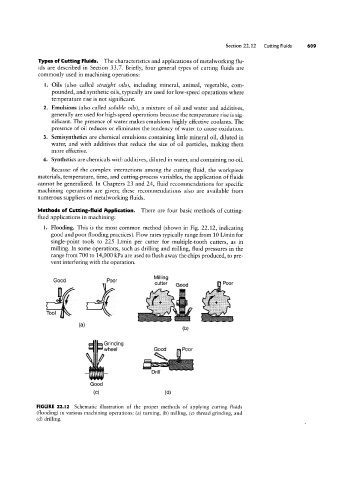Page 628 - 04. Subyek Engineering Materials - Manufacturing, Engineering and Technology SI 6th Edition - Serope Kalpakjian, Stephen Schmid (2009)
P. 628
Section 22.12 Cutting Fluids
Types of Cutting Fluids. The characteristics and applications of metalworking flu-
ids are described in Section 33.7. Briefly, four general types of cutting fluids are
commonly used in machining operations:
I. Oils (also called straight oils), including mineral, animal, vegetable, com-
pounded, and synthetic oils, typically are used for low-speed operations where
temperature rise is not significant.
2. Emulsions (also called soluble oils), a mixture of oil and water and additives,
generally are used for high-speed operations because the temperature rise is sig-
nificant. The presence of water makes emulsions highly effective coolants. The
presence of oil reduces or eliminates the tendency of water to cause oxidation.
3. Semisynthetics are chemical emulsions containing little mineral oil, diluted in
water, and with additives that reduce the size of oil particles, making them
more effective.
4. Synthetics are chemicals with additives, diluted in water, and containing no oil.
Because of the complex interactions among the cutting fluid, the workpiece
materials, temperature, time, and cutting-process variables, the application of fluids
cannot be generalized. In Chapters 23 and 24, fluid recommendations for specific
machining operations are given; these recommendations also are available from
numerous suppliers of metalworking fluids.
Methods of Cutting-fluid Application. There are four basic methods of cutting-
fluid applications in machining:
I. Flooding. This is the most common method (shown in Fig. 22.12, indicating
good and poor flooding practices). Flow rates typically range from 10 L/min for
single-point tools to 225 L/min per cutter for multiple-tooth cutters, as in
milling. In some operations, such as drilling and milling, fluid pressures in the
range from 700 to 14,000 kPa are used to flush away the chips produced, to pre-
vent interfering with the operation.
|\/inning
Good Poor cutter Good Q Poor
(3) (D)
W im Grinding
TE” wheel Good Q Poor
\§§ ..._. Q’\ .........._ .......
iiiiillil D""
Good
(C) (Cl)
FIGURE 22.l2 Schematic illustration of the proper methods of applying cutting fluids
(flooding) in various machining operations: (a) turning, (b) milling, (c) thread grinding, and
(d) drilling,

